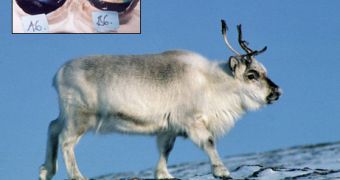Santa Claus will never come late.
Because scientists discovered Rudolph can take care of his eyes very well even without sunglasses.
Scientists have found that reindeers possess an unusual physiologic mechanism to deal with polar light extremes: they change their eye color and structure for summer and winter, which in the Arctic translates to permanent summer sunlight and 24-hour darkness in winter.
The British-Norwegian team, investigating reindeers in Lapland (northern Scandinavia), signals that this phenomenon has never been recorded before in mammals. The researchers detected that eyes removed from animals in winter were deep blue while the summer reindeer eyes were yellow. "This difference suggests the reindeer alter their vision seasonally to match prevailing light conditions," said study leader Karl-Arne Stokkan, an Arctic biologist at Norway's University of Troms?.
"It seems that the eye is reflecting what is the dominant light in the surroundings at the time, because in mid-winter the environment is predominantly blue. In summer, however, the reindeer's eyes reflect predominantly in the yellow part of the visible spectrum," Stokkan said.
Scientists did not know how Arctic animals (like reindeer, polar bear, polar fox) dealt with the extremes in brightness at polar latitudes, as for instance, the eyes of test rats exposed to similar conditions are "completely ruined".
This research points that the reindeer copes with this by operating changes in the reflective membrane behind the eye's retina, the tapetum lucidum ("bright carpet"). The tapetum improves visual sensibility in dark conditions by collecting light and redirecting it through the retina and it is well developed in species with good night vision, like dogs and cats.
The way collagen fibers are spaced in the tapetum tunes which spectrum range is being reflected. The fibers appeared further spaced in winter than in summer, determining the change in color reflections given by the reindeer eyes. "Similar shifts in tapetal reflection have previously been noted only in some marine animals, such as deep-diving sharks that adjust their vision to changing light levels", Stokkan said. "We have observed something which is absolutely real, but we have difficulties in explaining it. The leading theory to explain the adaptation is that in winter the animals increase the sensitivity of their vision at the expense of sharpness", he added.
During winter, the scattered predominant blue light is collected in the retina's rod receptors, responsible for night vision, instead of cone cells that work better in bright conditions. "The cones are responsible for high-resolution vision, but the rods are more light sensitive. So the reindeer may improve their sensitivity to low-light conditions by sacrificing their cone vision in winter", Stokkan said.
The blue winter reindeer eyes "helps the retina make the best of its signals when the lights go down," added co-researcher Glen Jeffery of the Institute of Ophthalmology at University College London. "The blue is favoring a dark environment. What you're seeing in the summer eye is the default state. It's just a bizarre adaptive mechanism-totally and utterly novel," said Jeffrey.
Now, researchers also want to investigate the phenomenon in living reindeer. They also want to research this in polar bear eyes, culled from nuisance animals occasionally killed in Svalbard archipelago.

 14 DAY TRIAL //
14 DAY TRIAL //